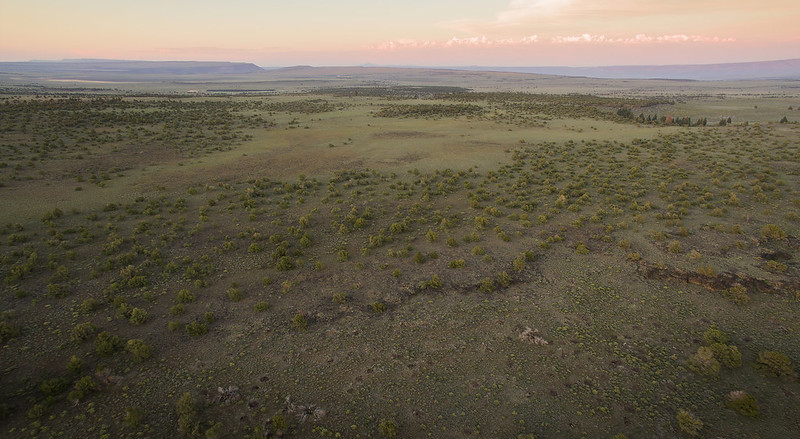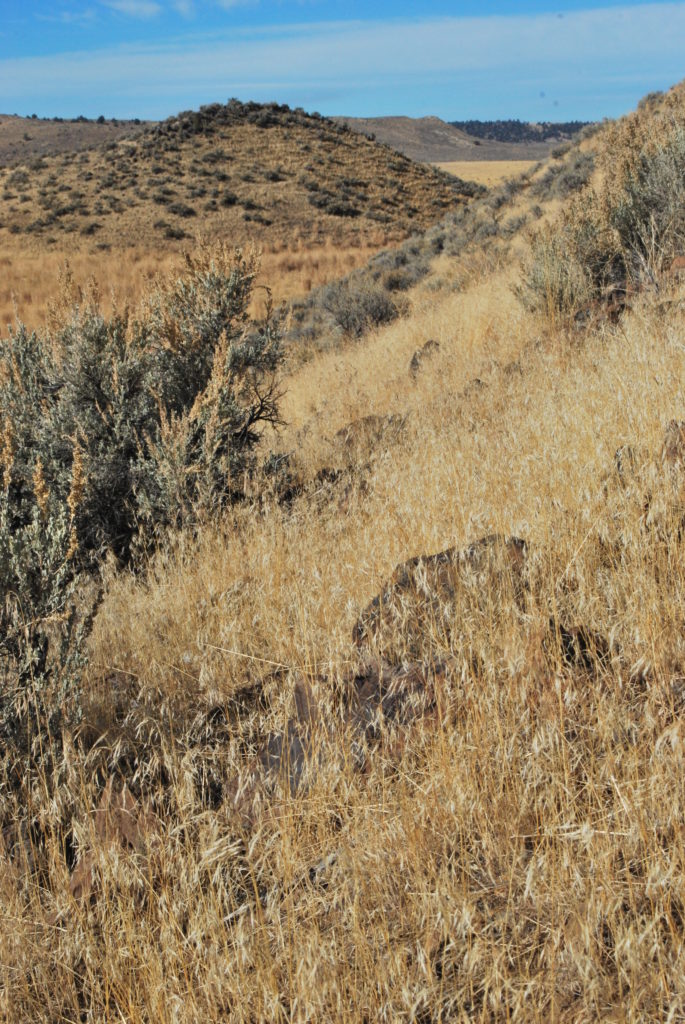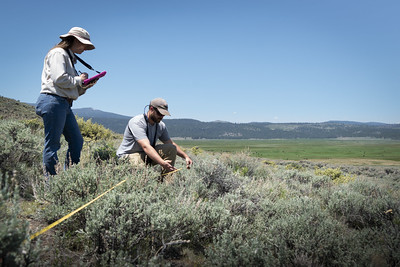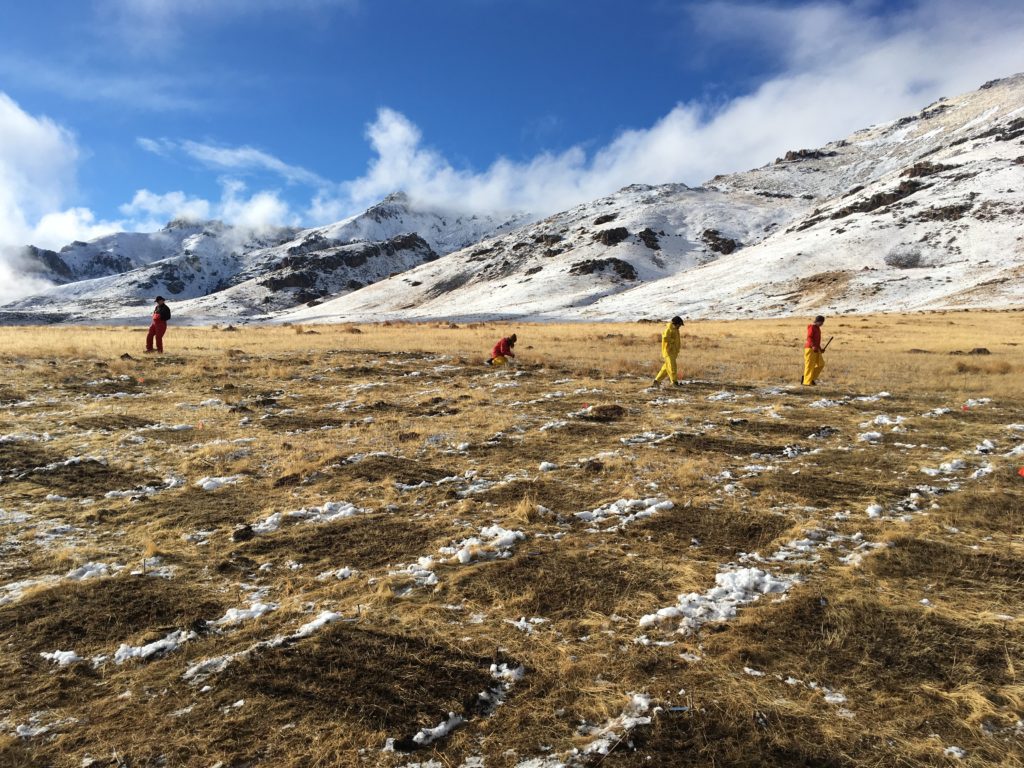Last updated on February 10th, 2024
The Place: America’s Vast Sagebrush Sea

For sagebrush ecosystems in the western U.S., land conservation is climate action. Stretching across more than 200 million acres, these rangelands are home to pronghorn, sage-grouse, and over 350 other species of conservation concern. But the expansive sagebrush sea is shrinking at an alarming rate due to wildfire, invasive species, and drought. When these healthy rangelands convert to weedy annuals, wash away with erosion, or burn up in smoke, we lose the carbon they keep stored in the soil and threaten this unique habitat.
In rangelands, durable carbon is stored in the soil and roots of long-lived perennial plants that return year after year. To keep this ecosystem healthy for wildlife habitat and the livelihoods of people who live and work here, we focus on protecting and restoring diverse, native, perennial plant communities. Because the sagebrush sea is so large, a modest amount of carbon per acre adds up to a huge reserve across the West. Most of the West is public land, administered predominately by the Bureau of Land Management and the U.S. Forest Service. Because these agencies are so important to the ecosystem, where The Nature Conservancy (TNC) and partners can help them improve policies and practices, the beneficial impact to wildlife habitat and ecosystem function can be significant.

The Problem: Invasive Weeds
Invasive species, especially annual grasses like cheatgrass and medusahead, displace native perennial grasses through competition and after wildfire. These invasives produce copious amounts of light, dry tinder that fuels larger and more frequent wildfires. Once these species get established, they tend to drive increasingly severe cycles of invasion and fire. Their rapid annual life cycles, prodigious reproduction rates, and easily transported seeds means invasive annual grasses are quick to colonize disturbed sites, spreading the problem across the range.
Sagebrush steppe invaded by annual grasses stores less carbon than intact sites. Combined with increased erosion of unstable soils and the emissions from wildfires themselves, disturbed annual systems may convert to carbon sinks, releasing more carbon into the atmosphere than they store. Adding to this, cheatgrass likely benefits from the increased atmospheric carbon dioxide levels of a warming climate, growing faster and larger and pushing the sagebrush steppe ecosystems even further away from their natural state. We are already seeing large areas of the sagebrush steppe convert into weedy annual systems, potentially permanent transitions that leave people, wildlife, and the climate worse off.
The Solution: Proactive Management & Improved Restoration
Keeping sagebrush ecosystems intact is a Natural Climate Solution, as healthy sagebrush steppe communities contribute an important co-benefit by maintaining belowground carbon reserves across hundreds of millions of acres. The unique dynamics of this systems – immense, remote, and publicly managed to a large extent – means TNC must work beyond just typical protection measures like land ownership and easements to support the ecosystem. Our land conservation solutions focused on resilient ecosystems will also maintain these relatively stable carbon reserves.
These efforts focus on proactive management and improved restoration to keep invasive annual grasses at a minimum and foster native perennial plant communities. TNC is investing heavily in developing innovative seed technologies that aim to help native species germinate and establish at higher rates, improving the success of restoration efforts. With management, TNC works closely with the Bureau of Land Management (BLM) and livestock producers to develop better regulations and practices that help both the agency and private landowners promote healthy rangelands. Traditional protection still plays an important role, especially where TNC helps private landowners secure conservation easements that keep ranches as working lands, limiting development of intact sagebrush habitats.
Solutions in Action: Innovation & Community Partnerships

What does this work look like on the ground? Here are a few examples where TNC has specific strategies designed to improve ecosystem resiliency for the unique qualities of this landscape, protecting stored carbon in the process.
Conservation Innovation
Successfully restoring sagebrush ecosystems, especially following increasingly large and severe wildfires, is a daunting challenge. Managers attempt restoration on hundreds of thousands of acres each year, often with poor results caused by unpredictable weather and a number of other barriers to restoration success. The western semiarid climate is particularly unpredictable; boom or bust is the norm with rarely an “average” year in between. Without rain or snow, native seeds struggle to establish, and without natives to compete against, invasive annuals thrive in the stark charred landscape of a post-fire world.
How can we give those seeds a fighting chance? TNC, together with government research scientists, is innovating with commercial seed coating and pelleting processes that can deliver extra nutrients, other beneficial compounds, or protection against herbicides that are needed to treat invasives. In each case, we are giving native seeds a boost to overcome a specific barrier limiting their germination and growth. These concepts, common in commercial agriculture, are cutting edge in wildland restoration. In partnership with seed coating companies, we are developing and testing a dozen prototypes across five states to improve restoration success. We aim to integrate successful technologies into the BLM’s immense and complex restoration infrastructure, the most important path to large-scale native species restoration. Widespread and successful restoration will promote carbon storage in sagebrush steppe habitats.
Engaging Communities

But every problem is a management problem too. Livestock grazing is a leading economic engine for many rural communities and the most common management consideration for sagebrush ecosystems. These communities also provide much of the labor, funding, and attention needed to restore and maintain the ecosystem. Where livestock grazing supports communities, communities can in turn support sagebrush ecosystems. However, grazing policies often lock producers into no-win situations that make them unable to respond effectively to wildfire, drought, and invasive annual grasses.
TNC has a portfolio of working ranches across the west, and each is exploring TNC has a portfolio of working ranches across the west, and each is exploring how we understand, test, and demonstrate rangeland conservation using livestock grazing systems. The Matador Ranch in Montana uses its pasture forage to improve management on home ranches of local producers by incentivizing actions to enhance wildlife habitat and requiring grasslands not be plowed which ensures vast stores of soil carbon remain in-place. At Utah’s Dugout Ranch, TNC is studying how heritage cattle breeds that require less water could still be economically viable in an arid climate. The Red Canyon Ranch in Wyoming works cooperatively with several local producers to graze specifically for better native vegetation conditions. In all these cases, using livestock to sustain and improve our rangeland resources can create a virtuous cycle that keeps in place native species and the carbon benefits they create.
Sagebrush: A Natural Climate Solution
Sagebrush ecosystems play an important role in the nation’s climate future. Keeping these places intact is a management problem and fixing them where they need it is a restoration problem, but both are climate solutions to keep more carbon in the soil across millions of acres. Because of the unique challenges of scale, ownership, and threats on the range, we need solutions that work for people, wildlife, and the climate together.
